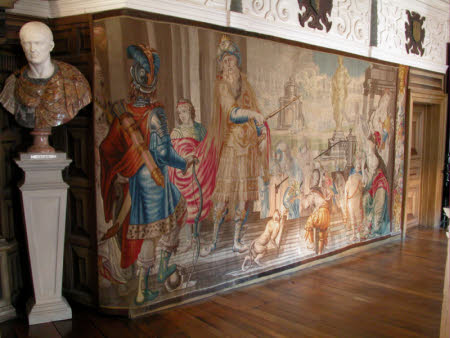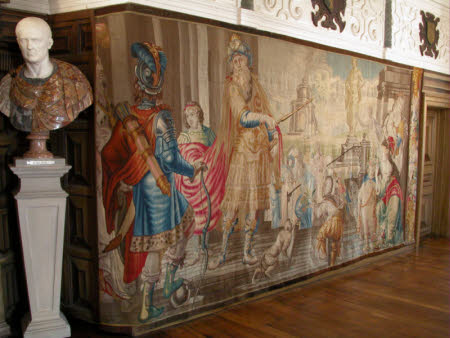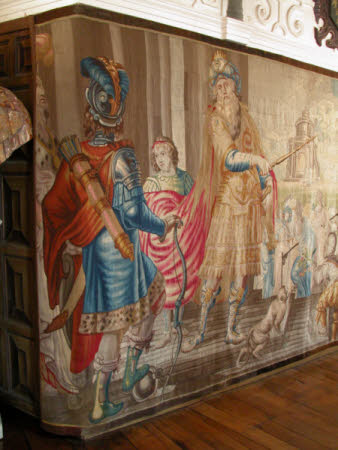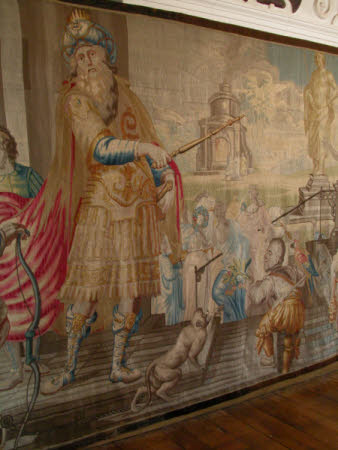The Golden Idol
probably Thomas Poyntz (fl. London c.1660, d. after 1688)
Category
Tapestries
Date
circa 1678 - circa 1686
Materials
Tapestry, wool and silk, 7 warps per cm
Measurements
2360 mm (H); 5150 mm (W)
Place of origin
London
Order this imageCollection
Powis Castle and Garden, Powys
NT 1181084.3
Summary
Tapestry, wool and silk, 7 warps per cm, The Golden Idol from a series of the Story of Nebuchadnezzar, probably Thomas Poyntz, London, c. 1678-1686. The scene is a marble platform with a balustrade and staircase leading down on the left, and a backdrop of a landscape with buildings. King Nebuchadnezzar stands to the left of the platform gesturing with his sceptre towards a golden statue which stands in the landscape beyond. He wears a gold breastplate and tunic, a blue turban with a huge jewel surmounted by a golden crown, and a red cloak which is carried by a page standing behind him. At the far left an elderly man wearing a plumed crown and an ermine-trimmed cloak approaches, but is partially hidden as the edge of the tapestry is folded in; to his right in the foreground a soldier stands with his back to us, resting his foot on a lead ball which is attached by a chain to the foot of a monkey which stands in the centre foreground. The monkey reaches with one paw to a fruited bough carried by a person with dwarfism who climbs the steps towards the king, wearing a silver doublet and gold pantaloons and hose and carrying a parrot on his shoulder. On the right two women approach the king, one kneeling to adjust the headdress of a child holding a censer, the other standing and carrying a naked infant. In the landscape beyond the marble platform a crowd of people gather to pay homage to the golden statue, and two women carrying wreaths of flowers descend the steps to join them. Beyond, in the distance, a temple-like building filled with flames and emitting clouds of smoke represents the fiery furnace. The tapestry was woven without upper or lower borders. The side borders are composed of putti climbing amongst festoons of fruit and flowers, with the head of a female herm at the top and a carved putto at the bottom peeing into a stone basin.
Full description
'The Golden Idol' is the second tapestry in the 'History of Nebuchadnezzar' set. King Nebuchadnezzar dreamt of a great statue whose head was made of gold, breast and arms of silver, belly and thighs of brass, lower legs of iron and feet of clay, and the statue was broken into pieces. Daniel interpreted this dream, saying the head of gold represented Nebuchadnezzar, and that his great kingdom would be followed by lesser ones, represented by the other materials. Nebuchadnezzar was awed by Daniel’s prophecy and rewarded him with high office; he also agreed to Daniel’s request that his brothers Hananiah, Mishael, and Azariah (or Shadrach, Mesach and Abed-nego as they were called by the Babylonians) be given control of the affairs of the province of Babylon, and that Daniel himself “be sat in the gate of the king” (Daniel 2:31-49). Nebuchadnezzar set up a great image of gold in the plain of Dura in Babylon. He commanded all his princes, governors and other officials to come and venerate the idol, and a herald told them that when they heard the sound of many instruments playing they should all fall down and worship the image. The main part of the tapestry represents Nebuchadnezzar ordering his people to worship the image; the women and children to the right of him are clearly on their way to do so, and in the background figures play trumpets and viols, while a procession approaches the image. The figure in an ermine-lined cloak on the far left probably represents one of the Chaldeans, who approached the King and told him that “certain Jews” were not obeying his command, and were not worshipping the golden image he had set up: these were none other than Daniel’s brothers Shadrach, Meshach and Abed-Nego. On hearing of their disobedience, Nebuchadnezzar “in his rage and fury” had them brought to him and told them that if they did not worship the golden image they would be “cast the same hour into the midst of a burning fiery furnace; and who is that God that shall deliver you out of my hands?” (Daniel 3:15). When the brothers still refuse the King had the furnace heated up to seven times its usual heat, and the brothers were bound and thrown in; but as the King watched he exclaimed to his counsellors, “Lo, I see four men loose, walking in the midst of the fire, and they have no hurt; and the form of the fourth is like the Son of God.” (Daniel 3:25). Daniel’s brothers emerged unharmed, without even the smell of smoke on their clothes. The Fiery Furnace is depicted in the background of the tapestry, a small building filled with flames and emitting a large plume of smoke, three small figures of Shadrach, Meshach and Abed-nego outside its entrance. The incident of the Fiery Furnace is also the subject of a fifth tapestry in the ‘Nebuchadnezzar’ series, which is not included in the set at Powis but does appear in the other three surviving sets. The dwarf and monkey in the middle of the tapestry do not appear in the biblical account and their significance is unclear. The dwarf may have been inspired by a dwarf in a print by Adriaen Collaert representing Daniel interpreting Nebuchadnezzar’s dream. The small boy in the right foreground resembles a boy at the head of another devotional procession in a tapestry of ‘Niobe’s Pride’ from a series of ‘Diana’ tapestries made by François Spiering in Delft between 1590 and 1610, an example of which survives at Knole. The four tapestries show scenes from the story of Daniel and Nebuchadnezzar, told in the Book of Daniel, chapters 1-5. Nebuchadnezzar, the King of Babylon, besieged Jerusalem and defeated Jehoiakim, the King of Judah. Nebuchadnezzar decided to take the brightest and most cunning of the children of Judah to be brought up in his palace, so that they might be taught the tongue of the high priests, the Chaldeans. Among the children taken were Daniel and his brothers Hananiah, Mishael, and Azariah. Daniel first came to the attention of King Nebuchadnezzar as a young man, when the king’s prophets had been unable to guess the meaning of his dreams. Daniel not only described the dreams, he was able to interpret their meaning; Nebuchadnezzar was awed by Daniel’s prophecy, and rewarded him richly. Later Daniel interpreted a second dream, foretelling that Nebuchadnezzar would be made to live with the beasts of the field if he did not mend his ways; this dream is the subject of the first tapestry in the series. The second tapestry shows the Golden Idol which Nebuchadnezzar set up, ordering everyone to pay homage to it; this scene also includes in the background Nebuchadnezzar’s brutal punishment of Daniel’s brothers for refusing to worship the idol, and their miraculous escape from the fiery furnace. The third tapestry represents the fulfilment of Daniel’s prophecy, and shows Nebuchadnezzar being struck down by the word of God, avian claws and feathers growing from his hands and arms. The final scene shows not Nebuchadnezzar but his son Belshazzar, who was just as bad as his father, leading an extravagant triumphal procession accompanied by Daniel, with servants carrying precious vessels stolen from the Temple in Jerusalem. Belshazzar himself was soon to be struck down by warning words from God in the middle of a banquet. The tapestries appear to have been woven without upper or lower borders, as part of the originally brown galloons are visible at top and bottom of some of the panels. The side borders are made up of an imitation carved and gilded Corinthian capitol above the head if a herm, and below this a winged putto securing a blue ribbon to the top of the column, which is joined to festoons of leaves and flowers which hang down filling most of the border. A second putto catches the blue ribbon lower down, and holds a flaming heart, and below its feet is a carved stone satyr mask. At the bottom is the carved and gilded figure of a third putto in the form of a fountain, standing on a stone ledge and peeing into a stone basin by his feet. During restoration the gilded putti on one of the tapestries, ‘The Golden Idol’, have been modified so that they are no longer peeing. Carved elements, putti and garlands were very common in the borders of both English and Flemish tapestries in the late seventeenth century, and this border has no particular relevance to the story of Daniel. The designer of the ‘Nebuchadnezzar’ series is not known. Wendy Hefford has noted similarities with a series of the ‘History of Jephtha’ woven in Antwerp in the late seventeenth century, suggesting that the designer may have been Flemish, although there is no direct evidence for this (Hefford 2002, p. 60). ‘Nebuchadnezzar’s Dream’, the first tapestry in the series, shows some similarities to a print by Adriaen Collaert representing the same scene. The dwarf in Collaert’s print is also very similar to the dwarf who appears in the tapestry ‘The Golden Idol’; moreover no dwarf appears in the biblical account. This tapestry includes another intriguing reference, in the form of a small boy bedecked in flowers being led to worship the Golden idol. The pose and attributes of this boy are closely related to a child in a tapestry of ‘Niobe’s Pride’ from a series of the ‘Story of Diana’ designed by Karel van Mander and woven by François Spiering in Delft between c. 1590 and 1610. Van Mander’s tapestry designs are not known to have been engraved, but a version of ‘Niobe’s Pride’ is today at Knole, along with another series of the ‘Story of Nebuchadnezzar’, and both sets were probably in the Royal Collection until the 1690s. Despite these borrowings, a single artist was almost certainly responsible for producing the suite of designs for the ‘Nebuchadnezzar’ series. No permanent designer is known to have been attached to the Poyntz workshop, where the tapestries were almost certainly produced, and none of the other sets of new tapestry designs they produced has been attributed to a particular designer. Of these a series of the ‘Story of the Eurcharist’ is based in part on a set of prints, but the sources for others such as the ‘Story of Don Quixote’ have eluded identification. The only painter known to have collaborated with the workshop is George Freeman, whose petition for the post of ‘chief designer of the King’s tapestry works’ in 1671 was supported by Sir Peter Lely, but the nature of his work is not known and he could have been charged simply with preparing cartoons (Lyte 1907, p. 80). The set at Powis Castle is one of four sets of ‘Nebuchadnezzar’ tapestries to survive. Of these only one, at Knole, is signed, with the initials T P either side of the white shield with a red cross of Saint George. The shield mark was first used at the Mortlake workshop from 1619 but by the later seventeenth century was a more general sign of English manufacture. The initials ‘T P’ are almost certainly those of Thomas Poyntz (d. 1685), an associate and possibly a relative of Francis Poyntz, Yeoman Arrasworker to Charles II from 1661 until his death in 1684. After the Restoration of 1660 Charles II became an active patron of the tapestry medium, as his father had been; but rather than exclusively using the workshop of Mortlake, established in 1619, he preferred to commission tapestries from the Royal Arrasworker, Francis Poyntz. Royal support for Mortlake ceased altogether in 1666, and from that date onwards Charles II commissioned a number of different sets from Francis Poyntz, often high-quality weavings with metal thread. Thomas Poyntz seems to have worked with Francis Poyntz in the 1670s and 1680s, and is first recorded in 1678 when the two men jointly signed a petition asking for concessions for immigrant catholic tapestry weavers in England (Thomson 1973, pp. 357-8). Thomas does not appear in Francis Poyntz’s will of 1684, where he left his workshop in the care of a doctor friend, asking him to provide for his children who were minors (National Archives, Prob/11/379). However despite this Thomas appears to have been involved in the continuation of Francis’s tapestry workshop in Hatton Garden until his own death in 1686. He sold a set of tapestries of the Months to the King in 1686, and his signature appears, amongst others, on a series of tapestries of the Battle of Solebay, woven in or after 1683, and a set of Eucharist tapestries at Ugbrook Park, Devon (Thomson 1973, pp. 358-9; Hefford 1988, p. 42). No record survives of a set of The Story of Nebuchadnezzar produced by either Thomas or Francis Poyntz, so the attribution to Thomas Poyntz rests solely on the signed series at Knole. The four surviving sets of Nebuchadnezzar tapestries all have different borders, and there are also slight variations in the designs, including the omission of figures or the addition of new figures in some of the versions of each scene, and some cases where a figure from one scene is moved to another scene in the set. There are also variations in the size of individual panels, indicating that some of the sets were tailor-made for an individual patron. The set at Knole with Thomas Poyntz’s signature is the finest quality, and gilt-metal thread is used in large quantities throughout the main fields. This strengthens the possibility that the set was made for the crown. The borders include male figures dressed as American Indians supporting vases of flowers at the sides, and hunting scenes with huntsmen, centaurs and animals amongst foliage at the top. The set was woven without lower borders. There are five scenes, including versions of the four subjects that appear at Powis plus a fifth, ‘The Fiery Furnace’. At Glamis Castle, Angus another series survives, containing the same five scenes as at Knole, although one, ‘Nebuchadnezzar’s Dream’, has been cut in half horizontally and the lower half is missing. This set is woven in wool and silk with a narrow acanthus-leaf border imitating a carved picture frame. Although some of the original galloons survive on this set, there is no discernable signature (Scott-Moncrieff 1950). Parts of a fourth set consisting of three known subjects, ‘The Fiery Furnace’, ‘Nebuchadnezzar’s Dream’ and ‘Nebuchadnezzar Transformed into a Beast’ has surfaced on the art market at various points during the twentieth century, and one panel is now in the Victoria and Albert Museum (V&A 1984). This series is woven with gilt metal thread and has a border design of scrollwork on a pale ground and an as yet unidentified monogram and ducal coronet at the centre of each horizontal border. The first record we have of the ‘Nebuchadnezzar’ set at Powis is in 1791, when a travel book advised that “The tapestry of the sextagon bedchamber represents several parts of ‘Nebuchadnezzar’s life’” (Brydges 1791, p. 32). The set is not mentioned by name in the 1891, 1908 or 1930 inventories of Powis, and was probably in London at this time: two tapestries from the set, ‘Nebuchadnezzar’s Dream’ and ‘Nebuchadnezzar Transformed into a Beast’ appear in a photo accompanying a Country Life article on the Earl of Powis’s house at 45 Berkeley Square in 1937 (Hussey 1937, fig. 6, p. 17). However this was only a relatively recent development: a notebook kept by the 4th Earl of Powis recording his alterations to Powis Castle records that “When I succeeded [in 1891] the walls of the State Dressing Room were hung with two pieces of tapestry of the “Nebuchadnezzar” set. The other two pieces were put away in a chest.” This is followed by an annotation: “1. is now in Gallery. The other three pieces in Berkeley Square.” (Powis n.d.) (Helen Wyld, 2010)
Provenance
Accepted by HM Treasury on 21st March, 1963 in lieu of tax, placed on long term loan to the National Trust, then gifted to National Trust on 26th March 1991.
Credit line
Powis Castle, The Powis Collection (The National Trust)
Makers and roles
probably Thomas Poyntz (fl. London c.1660, d. after 1688), workshop
References
Hefford, 2002: Wendy Hefford, ‘Flemish Tapestry Weavers in England: 1550-1775’, in Guy Delmarcel (ed.), Flemish Tapestry Weavers Abroad, Leuven 2002, pp. 43-61 Hefford, 1988: Wendy Hefford, 'Introducing James Bridges: new light on an English series of Eucharist tapestries.' Arts in Virginia, vol. 28 (1988), 34-47 Thomson, 1973: W G Thomson, A History of Tapestry from the Earliest Times until the Present Day, 3rd edition, Wakefield 1973 Scott-Moncrieff 1950: David Scott-Moncrieff, ‘Glamis Castle, Forfar’, Country Life, vol. cviii, no. 2805 (27 Oct. 1950), pp. 1412-7 Hussey 1937: Christopher Hussey, ‘An Historic London House: No. 45, Berkeley Square’, Country Life, 2 January 1937, pp. 14-18 Göbel, 1923: Heinrich Göbel, Die Niederlande, vol. 1 of Wandteppiche, 2 vols., Berlin 1923 Brydges 1791: Egerton Brydges, The Topographer for the Year 1791, London 1791 Herbert n.d.: William Herbert, 4th Earl of Powis, Manuscript Account of Bodley’s Alterations to Powis Castle, n.d.



